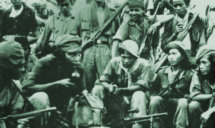Siliwangi Division
KODAM III/Siliwangi is a Military district formation of the Indonesian Army. The Division was formed during the Indonesian National Revolution by what was then known as the People's Security Army. It was stationed in West Java where much of its membership was recruited, and bore the name of a 15th Century kingdom located in this area and of that kingdom's King Siliwangi. it became a Territorial Division (Tentara & Territorium) on 24 July 1950, and a military regional command, or KODAM, in 1959.Since May 1946 the division was commanded by then-colonel Abdul Haris Nasution and his adjutant was Umar Wirahadikusumah, and slightly later Amirmachmud was the Division Commander's Chief of Staff. Kemal Idris was also among the division's officers. All of these would play a significant role in Indonesia's military and political life during the coming decades.
Under the terms of the cease-fire agreement of January 1948 known as the Renville Agreement, the Siliwangi Division was obliged to evacuate West Java and hand it over to the Dutch, and to move over to Central Java. During this lull in fighting the colonial troops, the Division was involved in the bloody crackdown on the Communists at Madiun, in the course of which thousands were killed.
In December 1948 the Dutch army launched the surprise attack known as Operation Kraai, swiftly capturing the Indonesian provisional capital at Yogyakarta and most Indonesian territory. The Siliwangi Division at that time conducted a fighting retreat back to its original position in West Java, where its men had their social milieu and were familiar with the terrain, and which was therefore the best suited for this unit to conduct guerrilla warfare in. Despite the division's recent anti-Communist record, this action came to be known as the Long March Siliwangi, for the famed Long March of Mao Zedong's Chinese Communist Party. On arrival in West Java the division fought both the Dutch and the rebellious DI/TII.
In 1953 Nasution wrote a book called the Fundamentals of Guerrilla Warfare, based on his own experience of fighting and organizing guerrilla warfare, which would become one of the most studied books on guerrilla warfare along with Mao's works on the same subject matter.
On January 23, 1950, a rebel group called Angkatan Perang Ratu Adil led by Captain Raymond Westerling attempted to seize Bandung during the APRA Coup d'xtat. Lt. Col. Lembong and 93 other Indonesian soldiers and officers were killed. On January 24, 1950, the rebels tried to attack Jakarta, but the rebellion was quashed in a fierce battle in Pacet, near Jakarta. Sultan Hamid II was arrested, but Capt. Westerling managed to escape to Singapore (then still a British colony).
In late 1951 the Division was described as being 'a loose umbrella for five infantry brigades strung across the western 3rd of Java.' The post of commander of Tentara & Territorium III, the territorial military command encompassing west Java, was in effect synonymous with control of the division.
Battalion 530 of the Siliwangi Division was involved in the 30 September Movement events in 1965. Following the later overthrow of Sukarno and the installation of the Indonesian "New Order" under Suharto, the Siliwangi Division's then commander, HR Dharsono, belonged to a faction dubbed by scholars as "New Order Radicals". Together with Kemal Idris and with Sarwo Edhie Wibowo of KODAM II/Bukit Barisan, this group wanted political parties to be dismantled and replaced with non-ideological groups which emphasized development and modernization.
Related Sites for Siliwangi Division
- PT Shinwoo Abadi, Jl. Raya Siliwangi Km. 1, Jatiuwing, Tangerang ... read Siliwangi Division
- museum and education, activities information at Bandung Tourism ... read Siliwangi Division
- Bandung Tourism official website - things to do read Siliwangi Division
- Everyday Spa | official site read Siliwangi Division


No comments:
Post a Comment